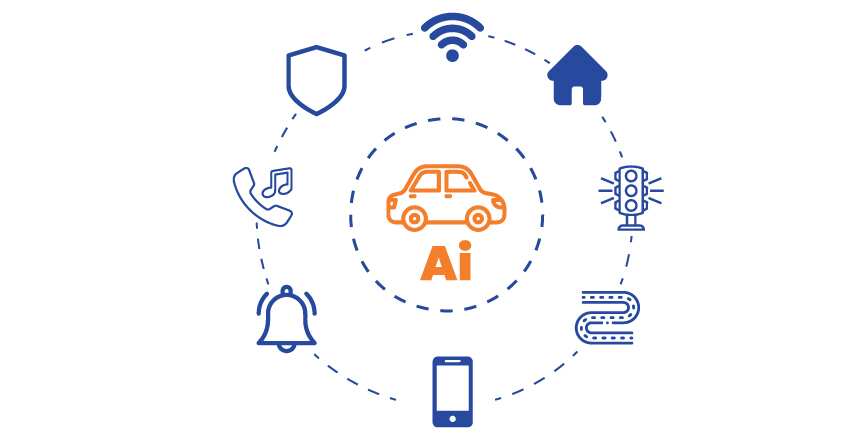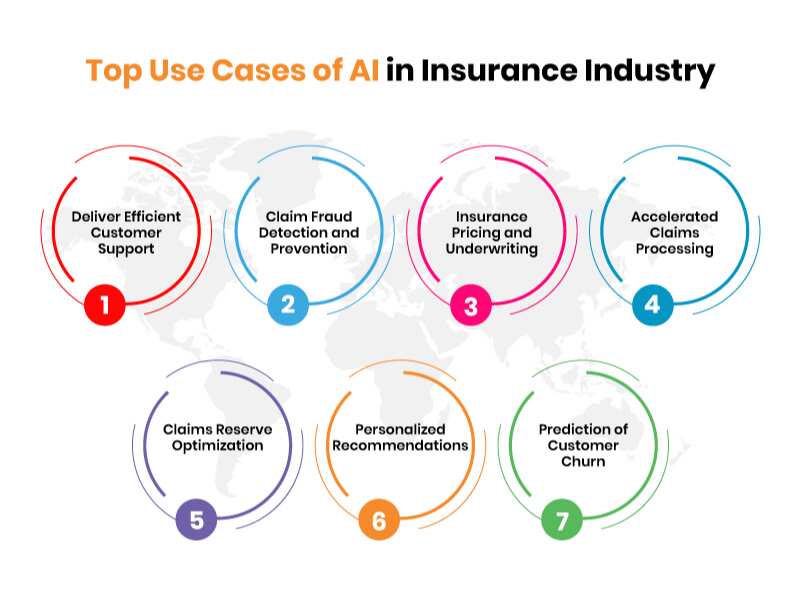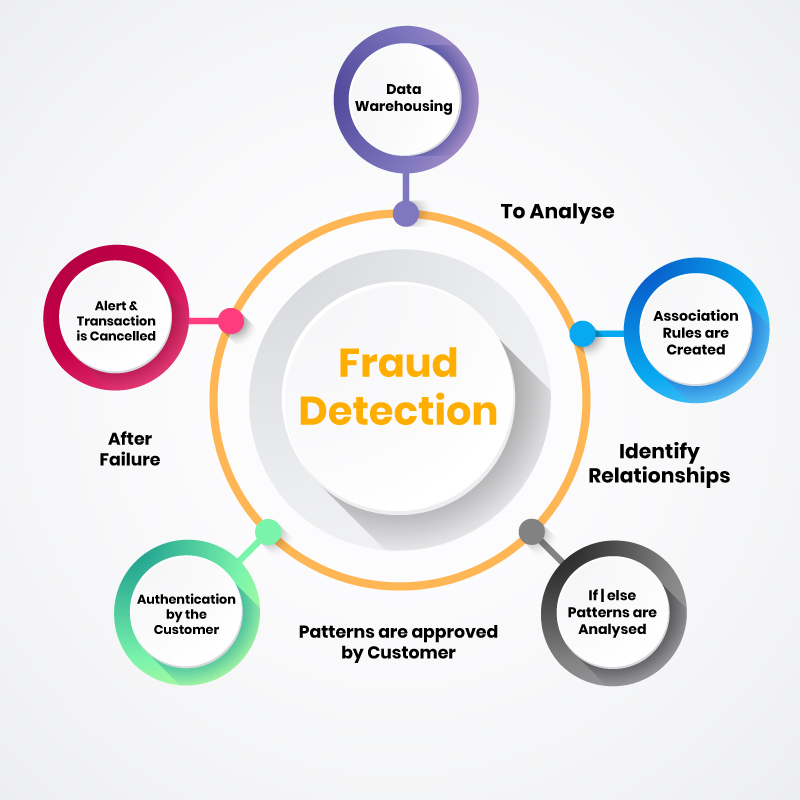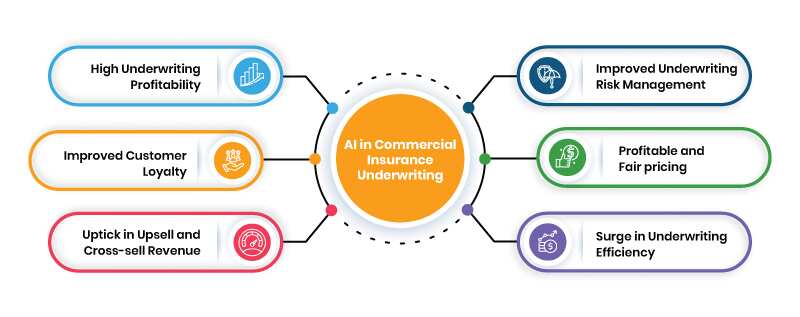Artificial Intelligence (AI) in Insurance Industry: Benefits & Use Cases
- February 9, 2022
- 25 mins read
- Listen

Table of Content
Would you prefer dealing with an insurance company that uses AI compared to one that does not? – Perhaps not. In 2024, with artificial intelligence booming across industries, people are less interested in old-fashioned services.
The insurance industry has too much paperwork. This slows down claims processing and other tasks. Customers often get dissatisfied with the services. Thus emerges the adoption of AI in insurance. AI creates opportunities for entirely new insurance experiences with fewer delays and higher customer satisfaction.
Travelers Insurance Company was among the early adopters of an IBM mainframe computer in the 1960s. This reliance on data analysis remained with the introduction of statistical models for pricing and risk assessment. According to data from the National Association of Insurance Commissioners (NAIC), 88% of automobile insurers use or are considering AI, with similar levels in house insurance (70%) and life insurance (58%). This demonstrates that the application of artificial intelligence in insurance businesses is steadily increasing. So, let’s look at the significance of artificial intelligence in the insurance market.
What is AI in Insurance?
AI in Insurance refers to the use of artificial intelligence to automate tasks, analyze massive volumes of data, track fraudulent activity, and perform a variety of other functions in the insurance industry. It also includes the creation of AI-powered scenario analysis tools. So that insurers can plan for complex market dynamics and regulatory changes.
How is AI Transforming the Insurance Industry?
Can you think back to a time when your insurance company operated without AI and had no automation? Previously, filing an insurance claim felt like you were waiting forever. Paperwork piled up, and human eyes cautiously examined every detail. Sometimes errors cause delays and frustration.
Fraudsters knew how to exploit the system. They escaped under the radar with clever tricks that manual checks couldn’t catch easily. Customer service meant waiting on hold. There was only hope for a helpful voice on the other end. Insurance products were one-size-fits-all solutions, priced carefully to cover all potential hazards.
With artificial intelligence in insurance, It’s no longer difficult to file a claim. AI systems filter through mounds of data in seconds. It’s able to highlight anything suspicious quickly. Claims are processed more quickly, errors are minimized, and you receive your payment sooner.
AI-powered chatbots are available 24/7, rapidly answering your queries and helping you through each step. Insurance firms employ artificial intelligence to better correctly identify risks. It allows them to provide you with bespoke insurance with just the right coverage at competitive pricing. AI fosters innovation by predicting trends and designing new solutions that are suited to your specific demands.
Which AI Technologies are Used in Insurance?
AI technologies for the insurance industry offer powerful solutions to various challenges. Innovation and uses are on the rise. In this section, we will briefly discuss the 7 most common AI technologies used in insurance.
- Natural language processing (NLP)
- Machine learning
- Deep learning
- Chatbots
- Cognitive Computing
- Simulation Modeling
- Regulatory Technology (RegTech)
1. Natural Language Processing (NLP)
Natural Language Processing (NLP) is a part of generative AI that helps you understand and interpret human language. You can analyze customer emails, claims forms, and social media posts quickly. This technology extracts important information and identifies customer sentiments. It improves customer satisfaction and reduces the workload on your service teams by ensuring prompt replies.
2. Machine Learning
Machine learning analyzes vast amounts of data to find patterns. This helps you predict future trends and assess risks accurately. Personalized insurance offers become easier with machine learning. It improves your decision-making, pricing models, and overall operational efficiency.
3. Deep Learning
Deep learning is an advanced form of machine learning. It recognizes complex patterns and makes high-accuracy predictions. You can use it for image recognition in claims processing or detecting fraud. This technology automates these processes, reducing errors and saving time.
4. Chatbots
Chatbots are AI-powered virtual assistants available 24/7. Chatbot for insurance companies handles inquiries, guides customers through claims, and provides policy information. Chatbots improve engagement by offering instant responses. They free up your human agents for more complex issues, enhancing customer service efficiency.
For example, insurance companies may consider REVE Chatbot for its transformative capabilities in customer services. Effortlessly handle an increasing volume of inquiries as the company grows with hybrid chatbot technology. Book a demo to learn more.
5. Cognitive Computing
Cognitive computing simulates human thought processes to analyze complex data. You can assess risk profiles and personalize insurance products with this technology. It enhances customer interactions by providing tailored solutions. Cognitive computing helps you deliver a better customer experience.
6. Simulation Modeling
Simulation modeling creates virtual scenarios to assess risks and outcomes. It helps you predict the impact of various factors on your insurance portfolio. This technology prepares you for different contingencies and optimizes strategies. It gives you a clearer understanding of potential risks and opportunities.
7. Regulatory Technology (RegTech)
Regulatory Technology (RegTech) helps you comply with regulations using AI. It monitors regulatory changes and ensures your processes follow laws. RegTech generates compliance reports and reduces non-compliance penalties. This technology keeps you up-to-date with legal changes, allowing you to focus on core business activities.
Key Benefits of AI in the Insurance Industry
The benefits of implementing AI in insurance seem clear to stakeholders in this ecosystem. Indeed, 84% of surveyed French investors believe AI will revolutionize the insurance sector. Moreover, 66% of insurers feel AI can help improve workforce productivity.
1. Increased Efficiency in Claims Reporting
Imagine your customers’ relief when filing a claim is quick and hassle-free. AI streamlines the claims reporting process. Customers can submit claims effortlessly through intuitive online platforms. This reduces their wait time. It ensures claims are processed faster. You enhance customer satisfaction by making the entire process more efficient. This builds trust and loyalty.
2. Streamlined Day-to-Day Operations
Day-to-day operations can often be bogged down by repetitive tasks and paperwork. AI automates these mundane tasks. This frees up your team to focus on more important work. Employees can dedicate their time to personalized customer interactions. They can also focus on strategic planning. This leads to a smoother workflow and higher productivity.
3. Real-Time Identification of Insurance Fraud
Insurance fraud can be a significant drain on resources and trust. AI helps you detect fraudulent activities in real-time. It analyzes patterns and anomalies in claims data. This swift detection protects your company’s finances. It also ensures that genuine claims are processed without unnecessary delays. Your customers feel more secure knowing that their insurer is vigilant. They appreciate your proactive measures in preventing fraud.
4. Fast and Accurate Damage Estimates
When your customers report damage, they want quick and precise assessments. AI technologies like image recognition provide fast and accurate damage estimates. They analyze photos and data quickly. This speeds up the claims process. It allows your customers to receive their settlements sooner. Accurate estimates mean fair compensation. This enhances your reputation for reliability and fairness.
5. Assisted Journey for Claims Investigation
The claims investigation process can be complex and time-consuming. AI assists by gathering relevant data quickly. It analyzes the data efficiently. This makes investigations more thorough. It also makes them faster. Your customers benefit from quicker resolutions. They feel assured that their claims are being handled with care and accuracy. This improved experience strengthens their trust in your services.
Conversational AI in Different Types of Insurance Policies
Conversational AI abilities allow it to understand the context of an entire conversation and adapt the response accordingly. The highly intelligent and personalized approach increases the customer’s confidence in the overall service, while improving the customer experience in the insurance industry.
Insurers can rely on AI chatbots to deploy on insurance processes by taking on the always-on customer service channel. Conversational AI enabled virtual agents can familiarize customers with various insurance policies and rank them based on customer needs.
Intelligent bots can ask the right questions and understand the customer’s needs and expectations. With Natural Language Understanding (NLP), it is easy to figure out the customer’s real intent based on their responses. Bots can also recommend the best policies based on the customer’s profile, risk assessment, and the type of cover needed.
Insurance AI solutions can be applicable across different type of insurance policies:
#1. AI in the Health Insurance Industry
Artificial intelligence is poised to become a transformational force in healthcare. AI health insurance offers some advantages over traditional analytics and clinical decision-making techniques.
AI in health insurance increases the ability for healthcare professionals to better understand the day-to-day patterns and needs of the people they care for, and with that understanding, they can provide better feedback, guidance, and support for staying healthy.
Many companies deploy AI in healthcare insurance.
Alayacare is a perfect case to the point for AI insurance Canada.
It offers a cloud-based software platform for home healthcare practitioners. The platform features clinical documentation, back-office functionality, remote patient monitoring, & telehealth. It also helps in analyzing wearable devices to fetch patient data for processing through machine learning technology by giving real-time insights for the care professionals.
Key AI Use Cases in Health Insurance
- Faster Disease Detection: AI in healthcare insurance detects issues and notify care teams quickly, enabling providers to discuss options, provide faster treatment decisions and ultimately save lives.
- More Accuracy in Diagnosis: AI and ML in health insurance help in assisting pathologists in making more accurate diagnoses and developing methods of individualized treatment.
- AI is a Great Symptom Checker: Deploying a healthcare chatbot will listen to the patient’s symptoms and health concerns, then guide the patient to the correct care based on its diagnosis.
#2. AI for Automobile Industry
The automotive industry is at the cusp of a phenomenal transformation. Automakers worldwide have started incorporating advanced technologies in their products and operations to ensure that they stay a step ahead of competitors in the market.
AI for motor insurance companies witnessed working its magic in an autonomous car using machine learning and also automating motor insurance underwriting with AI.
Here is an example of the largest general insurance company in Australia, IAG deploys AI to assess vehicle damage and reduce claim times.
The company uses an AI-based system to assess damage from motor vehicle accidents and speed up customers’ insurance claims. The support team can predict whether a car is a total loss following an accident, and by mitigating the need to tow the vehicle to a garage for assessment, can reduce claims processing times from weeks to days.
Key Use Cases for AI Auto Insurance
- Predictive Analytics for Manufacturing: The use of AI in vehicle manufacturing helps automakers reduce manufacturing costs and provides a safer and more efficient factory floor. It also helps in predicting malfunctions in automotive parts
- Vehicle Maintenance Recommendations: AI and ML algorithms for motor insurance companies help in providing recommendations to drivers about vehicle maintenance.
- Driver Behavior Analytics: AI auto insurance based automotive applications offer a plethora of valuable in-car analytics. Cameras and IR sensors can detect the driver’s behavior accurately and provide warning signals to avoid accidents.
#3. AI for Property Insurance Sector
AI-based technology is being applied to many different industries now, including the insurance industry, with residential and commercial property insurance. It has the potential to transform how property insurance works.
Artificial Intelligence helps to improve the claims process, making it faster and more accurate than ever before. Its ability to automate many tasks is making everything more efficient, which translates to better customer service and outcomes.
Key Use Cases: AI for Property Insurance Companies
- Risk Analysis & Underwriting: Using AI to analyze data can result in a more accurate assessment of potential perils, a determination of the best policy and coverage for your needs, and ways to reduce your risk of future claims.
- Fraud Detection: AI chatbots help to automate many processes that are often subject to fraud and take action without needing human support. It can also flag new policies, helping to identify people who are more likely to commit insurance fraud.
- Automated Claims Processing: AI can help customers report a claim, record damage or loss, verify policy and limits, communicate with customers, and alert customers and insurers about the status of claims.
#4. AI for Life Insurance Claims
The technology world is transforming rapidly, which is why the insurance sector is shifting with it, driven by customer expectations. To be competitive, insurance companies require more customer insights and the capability to turn these insights into action.
AI in life insurance offers the chance to increase revenue, improve efficiency, and reduce risk. AI has the ability to improve mortality, optimize decision-making to help build long lasting profitable customer relationships.
Utilizing AI in life insurance underwriting can be determined along with individualized pricing, disease severity prediction, submission prioritization, and rapid product development.
Life Insurance AI Help Insurers in Following Ways
- Marketing & Sales: A life insurance AI solution can help with customer segmentation, opportunity targeting, qualification of prospects, product recommendation, and personalization.
- Real time Engagement: Non-renewal costs insurers money, and AI can predict the likelihood of churn. Such predictions can be used to determine the appropriate renewal price change (RPC).
- Mortality Reserving: AI for life insurance claims can help you determine individual mortality reserving, as well as individual persistence estimating and overall profitability and cash flow.
#5. AI for Customer Communications
Insurers consider the changing customer needs and expectations, especially as they no longer tolerate lengthy insurance applications or a convoluted claims process. Integrating AI and automation into the customer communication model for insurance companies is critical.
With conversational AI enabling growth and disruption, insurers can address the demand for dynamic products and capture a new customer base comprising younger demographics.
AI in customer communications in the insurance industry has done a lot to improve customer experiences and operational efficiency.
Here is how AI in customer communications deliver a transformative experience:
- Increased Efficiency of Claim Process: AI helps to reshape the claims process for new and existing policy holders. Voice AI can help handle high call volumes by reducing the load on human agents. McKinsey predicts claims processing will remain the primary function of all insurers in 2030 & AI technology will reduce the overhead associated with claims by 70 to 90%.
- Policy Management: Automating the common customer requests like getting help with documents with AI enabled chatbot will deliver a better customer experience.
- Generating Quotes: Usually consumers have questions after receiving a quote. Voice AI can help consumers with these requests, thus insurers can save agents time until a complex query arises.
#6. AI for Commercial Insurance
Artificial Intelligence has the ability that allows programmers to create software that can identify patterns, extrapolate predictions and manage information more quickly and efficiently.
AI can easily spot patterns and flag risks in commercial insurance. Both new and established insurance companies are embracing artificial intelligence for these abilities.
Here is how AI in Commercial Insurance is Vital
- Better Data-Driven Decision-Making: AI in the commercial insurance industry, makes it easier to manage the massive quantities of data generated by both insurers and their customers.
- Faster Process: The AI algorithms control the amount of time committed to underwriting tasks decreases significantly. All the data is easily processed, and it takes less time than the traditional processes.
- Risk Evaluation: Applying AI to underwriting questions can be done by providing a more accurate view of underlying risk by accounting for factors that may not otherwise reach an underwriter’s attention.
Top 7 Use Cases of AI in Insurance Industry
Investments in artificial intelligence clearly payoff as McKinsey estimates that across functions and use cases AI investments can drive up to a whopping $1.1 trillion in potential annual value for the insurance industry.
So, what are those billion dollars deep pockets of value for insurance companies?
We have summarized some viable use cases where AI is impacting the insurance industry.
- Deliver Efficient Customer Support
- Claim Fraud Detection and Prevention
- Insurance Pricing and Underwriting
- Accelerated Claims Processing
- Claims Reserve Optimization
- Personalized Recommendations
- Prediction of Customer Churn
Let’s dive in.
1. Deliver Efficient Customer Support
More and more insurance companies are investing in chatbots as an integral part of their customer service to improve response time and save operational costs.
As customer service bots resolve simple queries quickly, your team saves time to handle complex queries and improve team productivity.
By transforming customer service interactions, AI-powered digital solutions are prepared to improve every aspect of your business including online customer experience, loyalty, brand reputation, and generation of revenue streams.
From gathering data to speech recognition and message response times, AI can enhance the customer experience in nearly every way when it’s applied correctly.
AI enables 24X7, always on, multi-channel customer service by deploying virtual agents (chatbots) and personalized interactive videos.
Here is how insurance in AI helps in delivering excellent customer service:
- Resolve Frequently Asked Questions (FAQs): AI chatbots can be deployed to address common FAQs raised by users. By solving over 50% of recurring questions from the outset, you can reduce support tickets, deliver efficient service, and save business costs.
- Learning Customer Behavior Patterns: AI in banking and insurance can be used to learn patterns of customer behavior and forecast later. The patterns can be used intelligently to offer the most likely service options or information based on the time and date of previous activities.
- Faster Response Times: Leveraging AI in insurance helps to speed up the response time of customer support agents. It helps to identify the customer needs and display the right information to the agents, thus bringing best-in-class customer service. Chatbots for banking do this task effortlessly and the same can be easily replicated in the insurance industry as well.
- Utilizing Natural Language Understanding: NLU helps in real-time analysis of customer service calls, chats, and emails, to understand the conversations better. AI allows reps to understand the customer’s issues and deliver quicker resolution.
2. Claim Fraud Detection and Prevention
Artificial intelligence (AI) plays a key role in insurance scam detection by detecting false claims. As a result, insurers can achieve an efficient and effective claims management system.
Insurance AI algorithms can analyze huge amounts of data rapidly to find patterns and spot anomalies that don’t fit the patterns.
From intelligent chatbots that offer 24×7 customer service to the range of machine learning technologies that bolster processes through automation, AI is already being used in many ways.
With increased awareness and resources about the game-changing influence of AI in the insurance industry, the initial hesitation and discomfort around its implementation are now minimal as there is more emerging evidence of the benefits that AI can deliver.
AI based insurance not only automates the scheduling of executive-level tasks but also enriches service quality by helping agents make the right decisions and irrefutable judgments.
Here is a look at some ways in which AI in insurance is making a difference in fraudulent claim detection and prevention:
- Big fraud schemes: Deployment of AI for insurance, internal and external databases contain data points that can be thoroughly cross-referenced and analyzed. It is a great way to simplify insurance fraud detection.
- Fraud Patterns: Using AI in insurance for fraud detection would become much more convenient.
For example, if a person claims that his smart phone is stolen, a search-run through databases can be conducted to look for any previous suspicious activity. If any is detected, a red flag can be raised so that an expert can dedicate more time to this claim.
3. Insurance Pricing and Underwriting
Underwriting is an essential part of the insurance through which insurers assess risk and determine premiums to accept it.
Evaluating and pricing risk requires extensive research on the risk profile of the customer. Consequently, manual underwriting is time-consuming, prone to errors, and can lead to inefficient pricing. It is why AI is the right fit for underwriting and risk pricing processes.
AI in insurance increases both efficiency and accuracy of the risk pricing process, creating competitive advantages for insurers that use the technology.
56% of insurance executives believe that AI would improve operational efficiency.
From deep learning to RPA and chatbots, applications of artificial intelligence enable insurance companies to conduct processes faster and more profitably.
Here are the key ways AI in insurance improves underwriting?
- Efficient Application Processing: Insurance AI helps Underwriters can automate data collection, data extraction, filling forms, or other repetitive tasks.
- Better Risk Assessment: Using AI and ML models in insurance and other analytical techniques, underwriters can deepen their understanding of the risk associated with customer profiles.
- Deliver Frictionless Customer Experience: With consumers expecting real time service across all digital touchpoints, AI in insurance has the ability to drastically shorten underwriting workflows.
- Improved Profitability: AI-based automation process improves underwriting profitability, while reducing operational costs, customer churn, and costs for retaining customers.
4. Accelerated Claims Processing
In the digital age, customers expect on demand, real-time and efficient submission and processing of claims.
The insurers now offer new ways of submitting claims, for example through submissions on smartphones or web portals.
Insurance AI systems now assist customers with the submission of claims, by guiding them through the claims process.
For e.g., an AI-powered claims bot can review the claim, verify policy details and pass it through a fraud detection algorithm before sending wire instructions to the insurance company to pay for the claim settlement.
How AI in insurance help to streamline claim processing:
- AI-based chatbots can be implemented to improve the current status of claim processes run by multiple employees.
- Driven by Artificial Intelligence, touchless insurance claim processes can remove excessive human intervention and can report the claim, capture damage, update the system, and communicate with the customer all by itself.
- The document capture technologies and optical character recognition can efficiently capture typed forms from the scanned documents.
- AI in insurance can now read the handwritten text at a level exceeding human capability.
- Many parts of the claims process are also being successfully automated, from claims routing to approvals.
It is how insurance companies make use of AI and such an effortless process will have clients filing their claims hassle free.
5. Claims Reserve Optimization
Undoubtedly, insurance companies need to take a deep dive and embrace digital and AI technologies to survive in today’s digital era.
Some of the top challenges in claims management are faced by insurers and the need to optimize their claims operations are the inefficiencies in the claims registration process. The process is data-intensive and repetitive, leading to operational inefficiencies.
How AI based Insurance solutions help in claim reserve optimization
- Handling Claims Estimation in Real Time: Using ML and AI in insurance saves a significant amount of time that is usually lost in preparing the data for analyzing claims.
- Early Detection of Fraud: Detects insurance fraud using AI technologies and helps eliminate the manual effort and intensive claim processes activities which result in delayed claims.
- Inspect Hazardous Locations: Leveraging AI in insurance helps to gauge damages, claims inspectors may potentially be exposed to safety risks, and false compensation claims.
Companies are embracing AI based insurance solutions to go the extra mile to stand out in the competitive market. The goal for all insurers is to improve revenue and reduce cost. They need to adopt innovative technologies and embrace the new ways of performing business.
6. Personalized Recommendations
Customers have different needs, preferences and lifestyles. They expect personalized policies, loyalty programs and recommendations, based on their individual preferences and attributes.
Engaged and satisfied customers are 80% more likely to renew their current policy.
Insurers are starting to provide tools that offer personalized insurance plans, based on Machine Learning and Artificial Intelligence models trained on individual customer preferences.
By deploying insurance chatbots, virtual assistants, you provide machine-generated insurance advice, to ensure that customers have adequate cover and deliver an excellent experience.
Voice bots can engage with customers and promote personalized offers. It will ensure that the customers are retained on the platform and not acquired by the competitors. They also share personalized recommendations and upsell other policies.
7. Prediction of Customer Churn
It is quite evident that the acquisition cost of new customers is substantially higher in the insurance industry than in many other sectors. It is much less expensive to keep an existing customer than to acquire a new one.
Insurance companies are utilizing AI based solutions for churn prediction to predict when customers may churn, enabling them to take proactive measures to keep their clients.
With the help of AI and Machine Learning algorithms, the leading indicators can be identified, such as changes in utilization of apps and rewards programs, a change of frequency of interacting with customer support, changes in income or changes in life circumstances.
The algorithms can also predict attrition in employees, by monitoring changes in work habits and employee satisfaction.
Thus, it is a win-win formula for both insurance companies and customers.
AI Adoption Challenges in Insurance
Adopting AI in the insurance business has huge potential, but it also comes with challenges. Understanding these barriers is necessary for a successful deployment.
Data Security
Data security is a significant challenge for AI adoption. Insurance businesses handle a large amount of sensitive client information. Protecting this data from breaches is often difficult. For example, if an AI system is hacked, clients’ personal and financial information may be compromised. It might have major implications for both the firm and its customers.
Pro Tip: Implement advanced encryption methods and regular security audits to protect sensitive customer information from breaches.
Infrastructure and Governance
Adequate infrastructure and proper governance is another challenge. Many insurance companies lack the necessary technology framework to support AI. This includes hardware, software, and skilled personnel. For instance, a company might struggle to integrate AI if its current systems are outdated.
Pro Tip: Invest in modern IT infrastructure and establish a dedicated AI governance team to oversee effective AI deployment.
Regulatory Compliance
Regulatory compliance plays an important role in the insurance industry. Companies must follow tight laws while deploying AI. These standards safeguard client information and ensure fair practices. For example, an AI system used for underwriting must adhere to privacy laws and anti-discrimination legislation. Failure to do so may result in penalties.
Pro Tip: Stay updated on regulatory changes. Work closely with legal experts to ensure your AI systems comply with all relevant laws and regulations.
The Future of AI in Insurance
The future of AI in insurance is bright, with the potential to revolutionize the industry through major changes.
1. Risk Management
AI in risk management will fundamentally alter how insurers assess and reduce risks. AI can identify emerging risks and predict trends affecting insurance portfolios by evaluating massive information in real-time. This will allow insurers to manage risks more effectively.
2. AI Underwriters
AI-powered underwriting systems are set to streamline the policy issuance process. These systems analyze applicant data, such as health records or driving behavior, to assess risk. determine premiums automatically. An increase in AI underwriting will speed up insurance companies’ overall functionality.
3. Automated Customer Service
AI-driven customer service solutions will transform how insurers interact with policyholders. Chatbots and virtual assistants powered by AI will take control. This might see a sudden shift of responsibilities in human agents.
4. Predictive Analytics
AI algorithms will be able to predict demand for specific insurance products based on demographic changes or market fluctuations. It will give insurers the ability to tailor their offerings and optimize premium strategies.
5. Fraud Detection
AI fraud detection systems will enhance insurers’ ability to detect and prevent fraudulent activities. Machine learning algorithms will be used more widely to analyze patterns in claims data and transaction histories. It will identify anomalies indicative of fraud. Slowly, people will be more comfortable to interact with AI in systems.
Best Digital Platform for Insurance AI
There are so many AI platforms for insurance companies available in the market backed with AI enabled insurance tools that will help insurers in smooth handling of tasks and delivering great customer experience.
REVE Chat is an acclaimed AI insurance software that offers the best digital platform with advanced tools for delivering excellent solutions for insurance. REVE Chat offers templates and a customized platform to build AI based insurance chatbots and deploy as per your use case.
Sign up with REVE Chat and explore the digital AI insurance platform, and how the tools help deliver excellent solutions.
Conclusion
AI is poised to disrupt the insurance industry like never before for both insurers and their customers. Customers may enjoy a more seamless user experience and more affordable rates.
Insurance companies might save money by making their processes more efficient or offering AI car insurance policies. With AI, the possibilities are boundless, and it is only a matter of time before we start seeing these improvements.
AI is a catalyst for transformation in the insurance industry. Some insurance companies are already using AI technologies to make more accurate predictions about risks; this allows them to set policies at a safer level.
Above it is described how automation and data analytics are being used to improve risk assessment, pricing, insurance underwriting processes, and customer engagement strategies for more accurate future predictions – all while reducing costs.
FAQs
1. What is the role of AI in the insurance industry?
AI plays a crucial role in insurance by automating tasks like claims processing and fraud detection. It sifts through vast amounts of data swiftly. This improves efficiency and accuracy in customer service and risk assessment.
2. How is AI used in insurance pricing?
In insurance pricing, AI dives deep into data analytics. It assesses individual risk factors with precision. Insurers can tailor premiums more competitively. This data-driven approach ensures fairness and affordability for policyholders.
3. How AI is used in policy making?
AI transforms policymaking by analyzing customer behavior and trends. It crunches numbers to predict future risks and preferences. This assists policy-making based on personalized insurance offerings.
4. Can AI replace insurance agents?
AI complements rather than replaces insurance agents. It streamlines administrative tasks, delivers predictive analytics, and enhances customer interactions. Agents remain indispensable for their expertise in complex scenarios and personalized advice.
5. How do insurance companies use AI to mitigate risk?
Insurance companies leverage AI to detect fraudulent activities swiftly and assess risks accurately. AI’s analytical prowess predicts potential losses and guides strategic decisions which fortifies risk management practices effectively.









